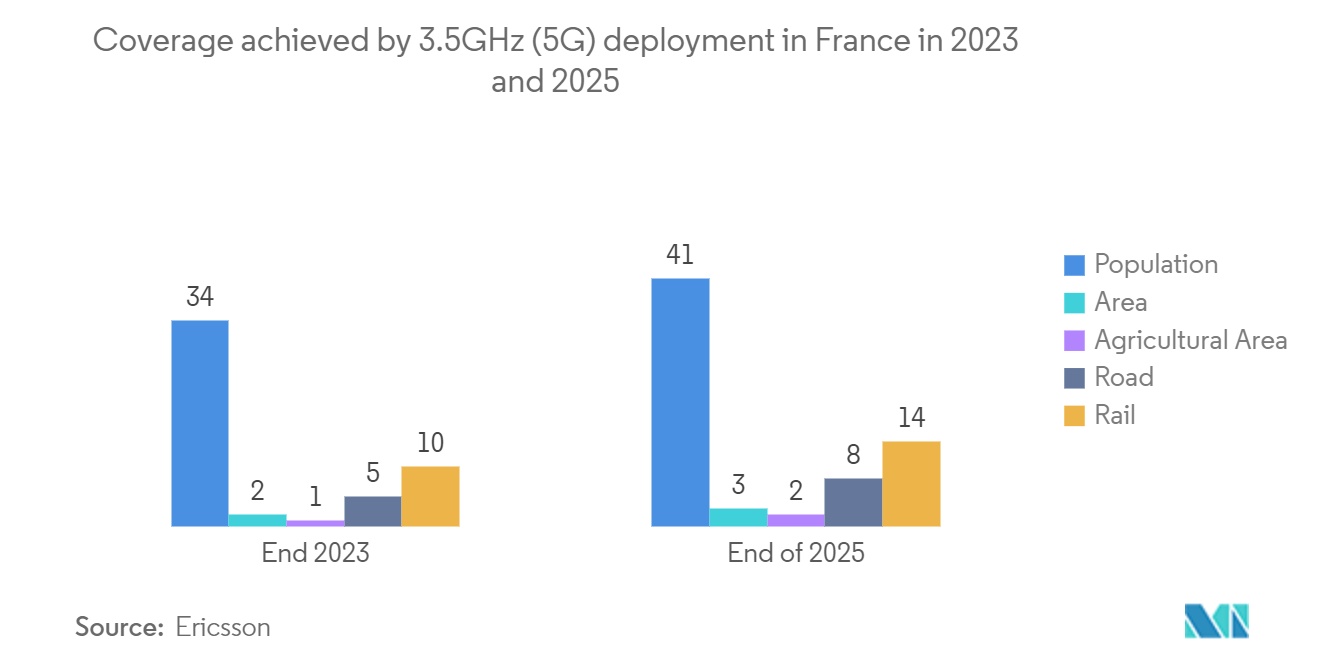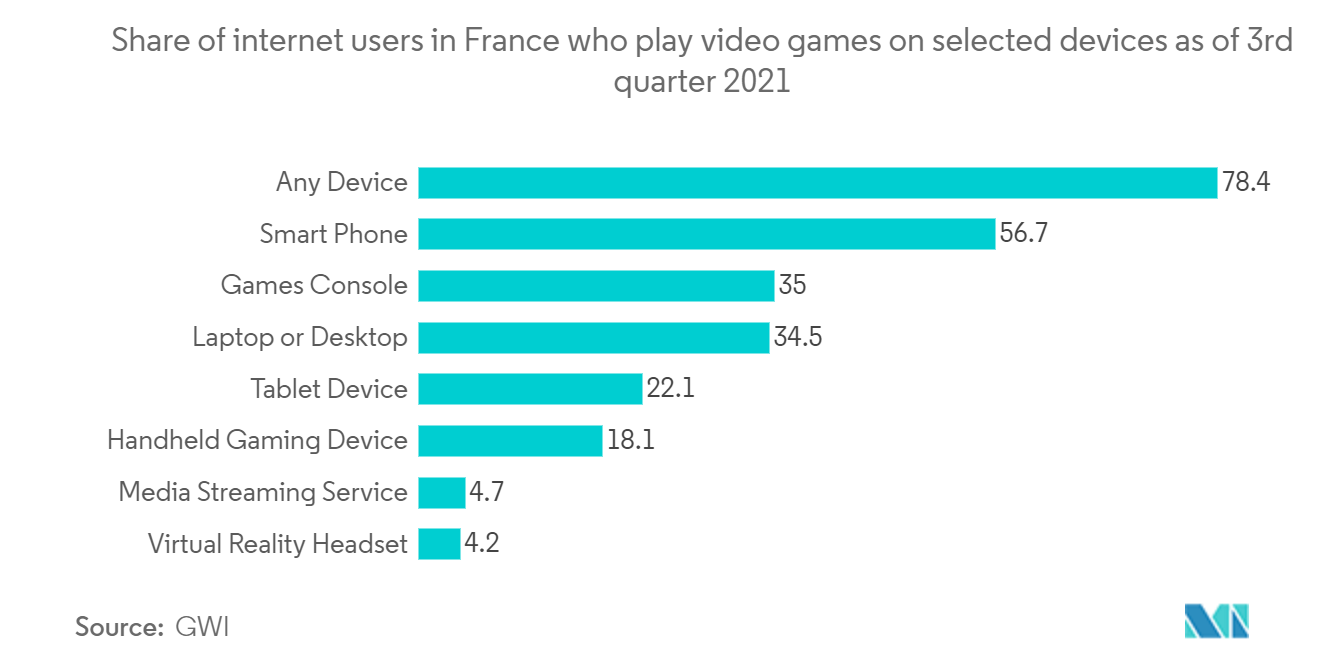Market Trends of France Telecom Industry
This section covers the major market trends shaping the France Telecom Market according to our research experts:
5G Rollout in the France Telecom Industry
- In Europe, France leads the deployment of 5G networks. According to a GSMA report, the most recent 5G Observatory report from the telecom watchdog, the Electronic Communications, Postal and Print Media Distribution Regulatory Authority (ARCEP), estimates about 22,000 mobile base stations in France offering 5G services for a fee. With approximately 13,470 sites, mostly in the 700 MHz bands, Free has the most 5G sites, followed by Bouygues Telecom (6,730), SFR (4,984), and Orange (3,035).
- French mobile operators use the 700 MHz, 2.1 GHz, and 3.5 GHz frequency bands to deliver 5G services. As per a GSMA report on 5G Drives French Digital Transformation, the final stages of the French 5G mid-band spectrum auction came to a finish in October 2020, and 310 MHz of spectrum in the 3.4-3.8 GHz range were granted. SFR paid EUR 728 (USD 717) million for 80 MHz, while Bouygues Telecom and Free Mobile (Iliad) each paid EUR 602 (593 USD) million for 70 MHz. Orange paid EUR 854 (USD 842) million for a total of 90 MHz. All mobile providers received authorization to utilize these frequencies shortly after, in November 2020. The 700 MHz frequency band, which ARCEP awarded in 2015, and the upcoming 26 GHz, which has not yet been allocated, are also available to operators.
- The French government is a strong advocate for the digitalization of the industry. The "France 2030" program allocated EUR 800 (USD 788) million to speed up the digital transformation of sectors using the cloud, 5G, and AI (AI). EUR 400 (USD 394) million will assist startups and creative firms in expanding their product line and EUR 400 (USD 394) million will assist industrial sites in their transformation. The French government unveiled an acceleration strategy for 5G and future telecommunications network technologies to take advantage of the 5G potential and take the country to the forefront of new digital uses. This initiative aims to add 20,000 new jobs, assist the development of the French 5G industry, and improve the ecosystem both domestically and abroad.
- The government is also inviting industrial enterprises to apply for a trial spectrum in the 3.8-4.0 GHz band in conjunction with ARCEP. Businesses from a variety of industries, such as manufacturing, logistics, health, and energy (among others), will be able to use a 100 MHz spectrum block for three years to test out various applications while taking advantage of the "mature and varied ecosystem of terminals and equipment" provided by being close to the mid-band spectrum band. 5G licenses for operators mandate of activating 5G features like slicing and other specialized services to meet the demands of sectors like automotive and healthcare.
- Nokia announced the 5G Innov Lab platform launch as part of the France Recovery Plan. The Nokia-led platform combines several organizations, including Airbus Secure Land Communications, Augmented Acoustics, Digital Immersion, IMT, SNEF Lab, Nokia Bell Labs, and Paris-Saclay Hardware Accelerator, to test and integrate 5G industrial users using an open and transversal approach. The 5G Innov Lab platform will rely on a private 5G network with three main focus areas: research and innovation, industrial and vertical use cases, and 5G trials on the 26GHz band. These frequencies are 2.6GHz TDD, 26GHz, and the 3.8-4.2GHz band.

Telecom Companies to Drive Digital Sustainability
- Telecom companies use their resources to assist their business clients in achieving their sustainability goals, and the outcomes are revolutionary. Around 2-3% of the world's carbon dioxide emissions come from the telecommunications industry, and most of the main firms have already started applying eco-friendly practices for operations. Many telco-related technologies, including the Internet of Things, 5G, cellular connectivity, and others, have enormous potential for tracking and measuring, which are essential to achieving sustainability.
- In July 2022, the ministers reaffirmed their intention for bold action during the working group's inaugural meeting on "Digital and Telecommunications." The French Telecoms Federation, with its four largest member representatives of the French tech ecosystem France Digitale, Numeum, and Start Industries, formed the Strategic Committee for the "Digital Infrastructure" sector. The participants collected the idea of structuring work to reduce energy usage, including exploring teleworking. They also wished to spread and promote good practices, particularly recent technological advancements that enable certain activities to have a smaller energy impact.
- All participants acknowledged their intention to cut energy use by 10% over the next two years. Work segregation will be done by separating participants with technological infrastructure from players in the digital economy and considering each group's unique characteristics. Players with technical infrastructure (such as telecom carriers) may, for instance, research the use of policies to reduce mobile networks' energy usage.
- As part of an effort to assess the digital environmental footprint in Frace, the French telecoms regulator, ARCEP, mentioned in its report that it would start evaluating the ecological impact of data centers. Since 2020, ARCEP has been gathering data, and in April 2021, it released the first iteration of its "green barometer," a tool for measuring the environmental impact of the country's telecom networks. The agency intends to include data centers in the barometer's upcoming iteration, along with data on a wide range of consumer electronics, including TVs, PCs, smartphones, routers, and set-top boxes.
- ARCEP aims to take a closer look at the device footprint and consider the data centers that handle the bulk of any online activity. According to an article published by the data center dynamics, ARCEP demands that businesses report on the number of devices in circulation, their lifespan, their greenhouse gas emissions, and the amount of rare earth and precious metals they contain. ARCEP claims that consumer devices account for 79% of the carbon footprint of digital technology in France. To conclude the data collection process, ARCEP is discussing the best way to incorporate the new data in its annual survey with the stakeholders.

